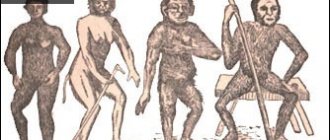What language did Adam and Eve speak?
Whether we recognize Darwinism and evolution or not, scientists still continue to search for Adam and Eve. Of course, not those who were expelled from the earthly paradise, but the real first men and women on our planet. They were distinguished from apes not only by their different physical structure, but also, above all, by their ability to speak .
Even in international academic circles, some consider Vitaly Shevoroshkin crazy. Others limit themselves to calling him a dreamer. Everyone agrees that he is a utopian. What is the fault of this Russian linguist who became a naturalized American? The fact is that he devoted his scientific life to a completely hopeless cause.
How hopeless it is, Shevoroshkin himself explains better than others: “The obstacles here seem insurmountable, the ground is unsteady, and the path of search is at least uncertain.” He is looking for a lost language, which he calls the “foremother of languages ,” that is, the prehistoric language that gave rise to all the languages of the world: the language spoken by the first homo sapiens, who appeared on Earth, according to paleobiologists, about 100 thousand years ago.
The difficulty is that almost no one takes Shevoroshkin seriously. His requests for funds to American universities were regularly rejected, and Yale University offered him a position on one condition: never discuss his “incredible” theory in class. To Shevoroshkin’s credit and for the sake of truth, it should be admitted that the theory of monogenesis of languages is regarded as plausible by many linguists. At the same time, however, it is considered unprovable and therefore inapplicable.
Indeed, all linguists, including Shevoroshkin, know that languages change over time by changing words and grammatical forms, and by acquiring and losing words. Given the relatively high rate of such changes, many linguists believe that the history of a language can be studied to a “depth” of no more than 5,000 years.
The situation becomes even more confusing if we add that when studying dead languages, scientists often cannot rely on “fossil” evidence, that is, written texts. The oldest examples of writing discovered in Mesopotamia go back only 6,000 years. And in regions such as Italy, the transition from prehistoric to historical occurred even later - some 2,700 years ago.
“If we, linguists, like archaeologists, had fossil materials, everything, of course, would be much simpler,” says Shevoroshkin. “However, there are no less rigorous methods and no less scientifically based concepts that make it possible to reconstruct the common origins of all languages.”
Let's look at a specific example: in German, Dutch and Swedish "hand" is pronounced "hand", in English - "hand", in Danish - "haand". To explain such a striking similarity, only three hypotheses can be put forward: it is a simple coincidence: the word was borrowed by one language from another; All the languages listed are of the same origin.
A random coincidence in relation to so many languages is mathematically impossible, especially since many other coinciding or similar words occur in these same languages. It is also necessary to exclude the assumption of borrowing, since “hand” is an elementary base word for any language. Thus, the third hypothesis remains: about a common root, in other words, that a given word goes back to the word of that single language that people spoke in the past.
In our particular case, we are talking about the Proto-Germanic language, which, although it has disappeared a long time ago, can still be reconstructed (“hand” in this language is “handuo”).
The next step is to identify the language from which both Proto-Germanic and Latin (the language that gave rise to the family of Romance languages) originate. This step was first taken by the Englishman William Jones, a judge from colonial India. While studying Sanskrit, the language that gave rise to Hindi and many other Indian languages, he discovered in it elements of similarity not only with Latin and Proto-Germanic, but also with ancient Greek and Celtic languages.
At a conference in 1786, Sir William announced his theory of the existence of a common Indo-European language. Subsequently, scientists proved that the Indo-European language was used in the Middle East and in the Caspian and Black Sea basins for several millennia, starting around 5000 BC. Then Sanskrit and Greek developed from it.
Over time, nine more proto-languages were identified, corresponding in time to Indo-European, including Afroasiatic (from which Arabic and Hebrew originate), Uralic (which gave rise to Finnish and Hungarian), and Altaic (the ancestor of Mongolian, Japanese, and Korean).
Already in the 19th century. Some linguists, having discovered the common linguistic origins and roots, began to reconstruct these dead languages. However, the lack of strictly scientific methods and the tendency towards approximation over time greatly discredited the very idea of such a reconstruction.
“I argue that the use of methods simply borrowed from the arsenal of comparative linguistics as such, like those used at the beginning of our century, is irresponsible and can only lead to distortion of the results,” Shevoroshkin explains. — It is strange that in the West, it seems, no one paid attention to the methodology of linguistic reconstruction, which has been used since the early 1960s. Soviet researchers. This methodology is scientifically flawless.”
THIS UNIVERSAL NOSTRATIC LANGUAGE
V. Shevoroshkin is referring to the work of V. Illich-Svitych and A. Dolgopolsky, who in 1963 announced the discovery of a number of words belonging to a prehistoric language spoken in the Middle East in a period 20-12 thousand distant from us . years, and from which six of the ten proto-languages identified to this day originated: Indo-European, Afroasiatic, Kartvelian, Uralic, Dravidian, Altaic.
Independently from each other, Illich-Svitych and Dolgopolsky began to analyze and compare the 25 most stable words of each language, words that are never borrowed, such as the first and second person pronouns “I - me”, “you - you”, as well as words denoting the main body parts: “eye”, “hand”, “tooth”, etc. Then the 50 most stable words were studied, etc. up to 500.
Knowledge about this ancestral language, which was dubbed Nostratic (from the Latin “noster” - “our”), has expanded significantly over the years. Today we already know more than a thousand words. We also know that in the construction of the Nostratic phrase the verb is at the end, and the verbs could be active, passive and reflexive, and during conjugation, the verbal forms of the first and second person singular were formed by adding pronouns meaning “me” and “myself” to the infinitive.
From the first thousand Nostratic words studied, we can conclude that the society that spoke this language was quite primitive and lived by hunting and gathering fruits. They did not yet have bows or arrows; they did not grow plants, and they had one single domestic animal - a dog (in Indo-European - “kuon”, in Nostratic - “kuina”),
“Our research,” adds V. Shevoroshkin, “leads to the conclusion that in the Nostratic era, man had already tamed the wolf. The fact is that the word “kuina” refers to both a dog and a wolf. This sociocultural fact was recently confirmed by archaeologists who discovered dog bones that are approximately 15 thousand years old.”
The Nostratic language was a language of “vital”: for example, it contained designations only for some colors, and in most cases these were words that named animals of the same color (similar to how we now say “mouse color”). There were no words in it at all , associated with feelings, states of mind, such as “love” or “pain”. There were only words for basic, essential concepts - hunger, thirst, etc.
In the same year that Illich-Svitych and Dolgopolsky announced the discovery of the Nostratic language, in the United States the Africanist J. Greenberg published his research proving that all African languages go back to four large families.
However, unlike Soviet scientists, Greenberg did not study or analyze pronunciation correspondences; he simply limited himself to compiling lists of the 300 words most consistently present in different languages and comparing them in search of a common origin. Despite the omissions and errors of this research method, the conclusions from his work have been accepted by almost everyone over the years.
Encouraged by this, the American linguist decided to apply his method to the study of the languages of the American continent and in 1987 announced the discovery of an Amerindian proto-language, different from the two previously known proto-languages - Nadene and Eskimo-Aleut, from which all current American languages received their origin.
For his part, V. Shevoroshkin, unlike Greenberg, in his search for the lost proto-language seeks to rely on the unquestioning work of about three dozen of his former colleagues. “In Russia, scientists continue to make progress: they recently proved that the Basque language belongs to the North Caucasian family, as probably Etruscan,” he says.
Well, when can we count on identifying the “mother” of all languages?
“The study of the proto-language itself is still just a hobby for me: in order to make such a leap into the depths of time, it is necessary to first create a solid base for running,” the scientist answers. — Language-speaking humanity appeared in Africa and about 100 thousand years ago divided into two branches. Some remained in Africa, while others moved to the Middle East. Thus, the first bifurcation was made in the linguistic family tree; on the one hand, an African language, on the other, a non-African language.
This latter then divided into three branches: the eastern, from which grew the Amerindian and Australian; the western one, from which the Nostratic and Dene-Caucasian languages were born, and, finally, the southern, or Congo-Saharan, which represents the languages of that part of the population that decided to return to Africa.”
V. Shevoroshkin is convinced that step by step it will be possible to restore these three proto-branches - eastern, western and southern - and ascend to their common trunk - a non-African language. When this is done, there will be one last - huge - leap into the darkness of the past: to the proto-language of Homo sapiens - the “mother” of all languages. This will probably be a very small, even negligible group of words...
Can Scripture be translated?
The language of the Church is the language of prayer, worship and Scripture. In some religions, sacred texts initially exist in one language and are considered fundamentally untranslatable. Thus, the Muslim Koran was originally compiled in Arabic. Moreover, Muslims believe that this is how this book was created at the beginning of time. Jewish scribes were also inclined towards the idea of the possibility of sacred texts only in Hebrew. This was not the case with Christian Scripture in the first place. In the 3rd century BC. The so-called “translation of the seventy” was completed - the Septuagint - a translation of the Old Testament into Greek. Moreover, some researchers believe that it was the Septuagint that played the role of Holy Scripture in intertestamental times. It was the existence of the Septuagint that became the main argument in favor of the fundamental translatability of Scripture. There is, however, an even stronger one. It is now considered proven that Christ spoke Aramaic to the apostles. But the compilers of the Gospels, without doubt, conveyed these conversations in Greek. Now there is a scientific direction - linguistic reconstructions. Their compilers are trying to understand how these dialogues sounded in the original. But this is still a subject of scientific research.
Did all Slavs understand the Bible?
The Scripture was not brought to our ancestors in Russian. Cyril and Methodius - the Thessaloniki Greeks - developed a new written language based on the spoken language of the Thessaloniki Slavs. There are many peoples in the world who use languages that do not have a written language. As long as we are talking about everyday life, there are no problems. But, as soon as a religious text or philosophical treatise needs to be translated into such a language, the language needs to be improved, which is what Cyril and Methodius did. If we assume that it was easier for Slavic tribes several thousand years ago to agree among themselves than for modern Slavic peoples, then we will be right - the languages were closer. But this does not mean that the translation of Scripture made by Cyril and Methodius was more understandable to the people of Kiev and Novgorod - the written literary language was different. Perhaps this is a feature of the Russian situation, since the Russian literary language is closer to Church Slavonic than to the Moscow dialect. In fact, the entire Church Slavonic language entered Russian as a “high calm”. For example, even modern participles - such as crying, running - are formed precisely according to the Church Slavonic model - in Old Russian it would be “crying”, “running”. Sometimes the Old Russian analogues were dropped out altogether - “good” and “bologoe” in the name “Bologoe”; “shelom”, which is only in epics, in contrast to “helmet”.
Priest or shepherd?
We live in a unique era. In Tsarist Russia the Bible could be read in Russian, in Ancient Rus' it could be heard in Church Slavonic. But the majority of the people were illiterate or not educated enough to read and comprehend Scripture. In Soviet times, everyone became literate, but there was no text of Scripture. Now literacy is still preserved and texts are accessible. In addition to the Scripture itself, we are invited to master a certain number of Slavic texts - from prayers to worship. True, the existing translation into Russian is somewhat difficult to understand. In the 19th century, having no analogues, translators often transferred Slavicisms into translation. This is how the phrase “I am the good shepherd” was translated into translation. And there are some difficulties here. A literal translation from the Greek would be: “I am a good shepherd,” but such a translation is perceived as low. On the other hand, now the simple listener will perceive the sublime “shepherd” rather as “priest.” However, it must be admitted that a literal translation into Russian of many biblical sayings is impossible - the phrase “through the lips of a child the truth speaks” will not be perceived as a philosophical saying. But in general, the perception of the Slavic text of the Bible is hindered more by a lack of understanding of the meaning, rather than the words. A separate difficulty is grammatical structures. For example, there are a number of enhancements that come from Greek. “Forgive sins and trespasses” simply means forgive all sins. Constructions such as “I was angry with anger” and “I loved with love” are similar. When translating sacred texts into other languages, problems also arise (although the peoples into whose languages the Scriptures have not yet been translated are, perhaps, 5℅ of the Earth's population). That is, the work that Cyril and Methodius did for the Slavs continues. Cyril and Methodius were not the first - before that there were translations into Ethiopic and Gothic. After Cyril and Methodius, Stefan of Perm translated the Scriptures into the Zyryan language.
Is it really cold in heaven?
When translating a language into a language, problems sometimes arise because the languages are not grammatically identical. The meanings and shades of words in different languages are also different. For example, the phrase “paradise is a green and cool place” clearly shows that Scripture was created in countries with a hot climate, where “coolness” is rather pleasant. In Russian such associations would hardly arise. And the verb “chill” in the sense of “relax”, “have a good time” came into Russian as a tracing paper from Hebrew through Greek.











